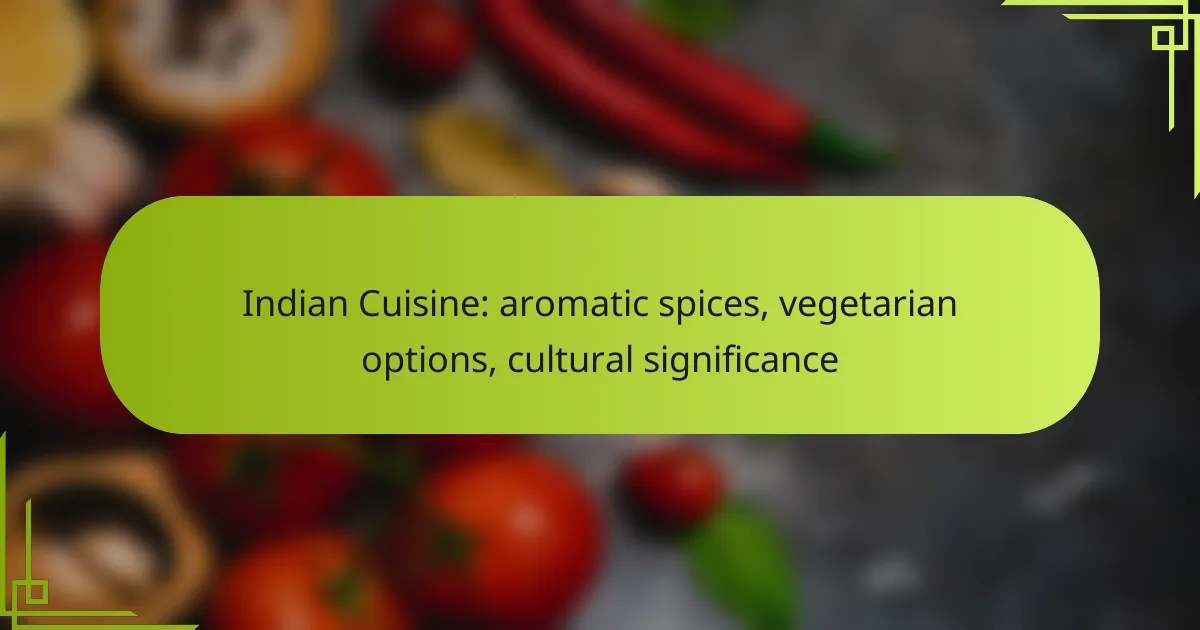Indian cuisine is renowned for its vibrant array of vegetarian dishes that celebrate aromatic spices and fresh ingredients. Each dish, from Paneer Tikka to Vegetable Biryani, offers a unique flavor profile and carries deep cultural significance, reflecting the rich traditions of the region. Spices not only enhance the taste and aroma but also symbolize the intricate tapestry of Indian heritage, influencing culinary practices and societal rituals.

What are the best vegetarian dishes in Indian cuisine?
Indian cuisine offers a rich variety of vegetarian dishes that highlight aromatic spices and fresh ingredients. Some of the best vegetarian options include Paneer Tikka, Chana Masala, Palak Paneer, Dal Tadka, and Vegetable Biryani, each with unique flavors and cultural significance.
Paneer Tikka
Paneer Tikka is a popular Indian appetizer made from marinated cubes of paneer (Indian cottage cheese) that are grilled or baked. The marinade typically includes yogurt and a blend of spices such as cumin, coriander, and garam masala, giving it a smoky flavor.
This dish is often served with mint chutney and is a favorite at parties and restaurants. When preparing Paneer Tikka at home, ensure the paneer is fresh for the best texture and taste.
Chana Masala
Chana Masala is a hearty and nutritious dish made from chickpeas cooked in a spicy tomato-based gravy. This dish is rich in protein and fiber, making it a staple in many vegetarian diets across India.
To enhance the flavor, ingredients like onion, garlic, ginger, and a variety of spices such as turmeric and cumin are used. Chana Masala pairs well with rice or flatbreads like naan or roti.
Palak Paneer
Palak Paneer features paneer cubes simmered in a smooth spinach gravy, making it both nutritious and flavorful. The dish is often seasoned with spices like garam masala and is known for its vibrant green color.
This dish is not only rich in iron and calcium but also provides a delicious way to enjoy leafy greens. Serve Palak Paneer with rice or Indian bread for a complete meal.
Dal Tadka
Dal Tadka is a comforting dish made from lentils cooked until soft and then tempered with spices and ghee. The tempering usually includes ingredients like cumin seeds, garlic, and dried red chilies, which infuse the lentils with rich flavors.
This dish is a staple in many Indian households and is often served with rice or chapati. For added flavor, garnish with fresh cilantro before serving.
Vegetable Biryani
Vegetable Biryani is a fragrant rice dish cooked with mixed vegetables and aromatic spices. The layering technique used in biryani allows the flavors to meld beautifully, resulting in a satisfying meal.
Common vegetables used include peas, carrots, and potatoes, along with spices like saffron and cardamom. Serve Vegetable Biryani with raita (yogurt sauce) for a refreshing complement to the spices.

How do spices enhance Indian dishes?
Spices are essential in Indian cuisine, enhancing flavor, aroma, and color while contributing to the overall sensory experience. They create a complex interplay of tastes that can range from sweet to savory, making each dish unique and memorable.
Flavor profiles of spices
The flavor profiles of spices in Indian cooking are diverse and intricate. Spices can be categorized into several taste groups, including sweet, sour, bitter, pungent, and salty. For example, cumin adds earthiness, while cardamom brings a sweet, floral note, creating a balanced flavor spectrum in dishes.
Understanding these profiles helps in crafting dishes that are harmonious and appealing. Combining spices thoughtfully can elevate a simple meal into a culinary delight, allowing for creativity in both traditional and modern recipes.
Health benefits of spices
Many spices used in Indian cuisine offer significant health benefits. For instance, turmeric contains curcumin, known for its anti-inflammatory properties, while ginger aids digestion and can reduce nausea. Incorporating these spices into meals can contribute to overall wellness.
Additionally, spices like garlic and cinnamon have been linked to improved heart health and blood sugar regulation. Utilizing a variety of spices not only enhances flavor but also promotes a healthier diet.
Commonly used spices in Indian cooking
Some of the most commonly used spices in Indian cooking include cumin, coriander, turmeric, and garam masala. Cumin seeds are often used in tempering, while coriander powder adds a citrusy flavor to curries. Turmeric is a staple for its vibrant color and health benefits.
Garam masala, a blend of various spices, is typically added at the end of cooking to enhance aroma and flavor. Familiarizing yourself with these spices can significantly improve your cooking and help you create authentic Indian dishes.

What are the cultural significance of spices in India?
Spices hold immense cultural significance in India, serving not only as flavor enhancers but also as symbols of tradition, trade, and spirituality. They are deeply woven into the fabric of Indian society, influencing cuisine, rituals, and even economic practices.
Historical trade routes
India has been a pivotal player in the spice trade for centuries, with historical routes connecting it to various parts of the world. Spices like black pepper, cardamom, and cinnamon were highly sought after, leading to the establishment of trade links with Europe, the Middle East, and Southeast Asia.
The lucrative spice trade contributed to India’s wealth and cultural exchanges, shaping its history and interactions with other civilizations. The legacy of these trade routes is still evident today in the diverse culinary practices found across the country.
Religious rituals
Spices are integral to many religious rituals in India, symbolizing purity and auspiciousness. For instance, turmeric is often used in Hindu ceremonies for its cleansing properties, while saffron is associated with prosperity and is used in offerings.
During festivals, spices are not only used in cooking but also in rituals to invoke blessings and enhance the spiritual atmosphere. Their aromatic qualities are believed to attract positive energies, making them essential in various cultural practices.
Regional variations in spice use
India’s vast geography and diverse cultures lead to significant regional variations in spice use. For example, the use of mustard seeds is prevalent in Bengali cuisine, while South Indian dishes often feature curry leaves and tamarind.
These regional preferences reflect local agricultural practices, climate, and historical influences, resulting in a rich tapestry of flavors across the country. Understanding these variations can enhance one’s appreciation of Indian cuisine and its cultural context.

How to select authentic Indian spices?
Selecting authentic Indian spices involves looking for freshness, quality, and origin. Opt for whole spices when possible, as they retain flavor longer than pre-ground options.
Choosing quality spices
To choose quality Indian spices, examine their color, aroma, and packaging. Fresh spices should have vibrant colors and a strong, fragrant scent. Look for spices packaged in airtight containers to ensure they remain potent.
Consider sourcing spices from reputable vendors or local markets known for their authenticity. Buying in small quantities can help maintain freshness and allow you to try a variety of spices without waste.
Understanding spice blends
Indian cuisine often features spice blends, known as masalas, which combine various spices for depth of flavor. Common blends include garam masala, curry powder, and chaat masala, each with unique profiles and uses.
When selecting spice blends, check the ingredient list for authenticity. Avoid blends with artificial additives or excessive fillers. You can also create your own blends at home, tailoring them to your taste preferences and ensuring freshness.

What are the emerging trends in Indian cuisine?
Emerging trends in Indian cuisine reflect a blend of traditional flavors with modern culinary practices. This includes the rise of fusion dishes, innovative plant-based options, and a growing emphasis on sustainability and health-conscious ingredients.
Fusion cuisine examples
Fusion cuisine in Indian cooking combines elements from various culinary traditions, creating unique dishes that appeal to diverse palates. For instance, Indian tacos feature spiced fillings wrapped in tortillas, while curry pizzas incorporate traditional Indian sauces and toppings on a classic Italian base.
Another popular example is the use of Indian spices in Western dishes, such as masala burgers or tikka pasta. These creative combinations not only enhance flavor but also introduce Indian culinary techniques to a broader audience.
Plant-based innovations
Plant-based innovations in Indian cuisine focus on enhancing vegetarian dishes with new ingredients and cooking methods. This trend has gained traction due to the increasing demand for healthier and more sustainable food options. Dishes like jackfruit biryani and lentil-based burgers showcase how traditional vegetarian recipes can be reimagined.
Additionally, the use of alternative proteins, such as chickpeas and quinoa, is becoming more common. Chefs are experimenting with textures and flavors to create satisfying plant-based meals that cater to both vegetarians and meat-eaters alike.










